

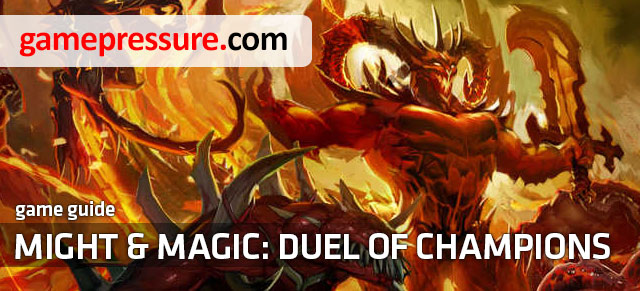
From this guide to the Might & Magic: Duel of Champions game, you will learn about:
1. The interface, the gameplay rules and its modes.
2. How to deal with the enemies in the series of campaigns, contained in the game, without the specific cards.
3. How to construct diverse types of decks of cards, to prevent the enemies from putting you in an inconvenient situation during the battle, and to allow you to counteract against the enemy's strategy.
Each one of the five factions has a hidden potential characteristic for it. Even the cards of the neutral faction can make scales turn in your favor during important duels for your ranking position, or while battling with a friend.
Further part of the guide has been color coded in the following manner:
Maciej "Maxie" Mienko
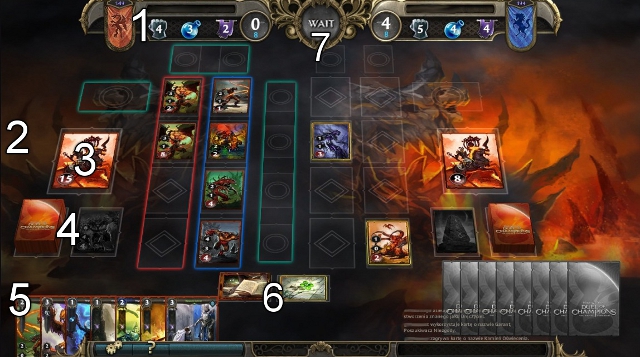
The game screen has been divided into two, nearly identical, parts. To the left, it is where you are, with the opponent to the right. By clicking any card, you can zoom it in to read about skills.
1. the player information window. This is where your standard is displayed (which can be changed in your profile), player's name and statistics that concern the current match.
Might, magic and fate - these are your three statistics, which decide about the cards that you are capable of playing. Every turn, you can raise one of the statistics. They are symbolized by a grey fist, a blue vial and a violet standard respectively.
Resources - Points that allow you to lay down your cards, i.e. movement points. Every round, these reset to the maximum amount by default. With each turn, the maximum number of your resource points increases with each consecutive turn. Resource points are symbolized by a circle with plain rims.
2. the background is more of a visual curiosity than a useful element of the interface. It presents the deck's, or the player's character's faction.
3. Hero card is where raising of statistics, taking more cards or using of special abilities takes place.
4. Two stacks of cards. From the left:
A deck can be made up of 59 (including one hero and eight events) to 209 cards.
Graveyard - That is where all of the cards make, after they have lost their health points, or after being used up, in the case of Spell and Fortune cards
5. Hand - A collection of cards that you can lay down at the beginning of your turn, if you have met all of the condition described on the card. After you lay down a card, you bear all the costs connected with this action (usually in terms of resources). At the beginning of your turn, you receive another card from the deck. At the beginning of the match, you are presented with a suggestion of the cards that you are currently holding. If necessary, this suggestion can be re-shuffled once.
6. the spot that the events are in. The events can be initiated by both players after bearing the cost stated by that event.
7. Turn-end button.
Green slots- slots for spells that remain effective for more than one turn and are not put over a single card. A single slot next to the hero concerns spells cast over the entire army or over the hero himself. The rest of the slots correspond to the spells cast over individual row, depending on the card's effect.
Blue slots- Slots for close-range or airborne units.
Red slots - Slots for long-range or airborne units.
The cards can be divided into five general types, which is: Heroes, Units, Spells, Fortune and Events. There are variations to each of these groups.
It is a division that concerns Heroes, Units and Fortune. Each of the fractions has a different approach to the play style. They are divided as follows:
Inferno - An especially offensive faction. While playing the Inferno, you will be able to deal severe, often sweeping damage which, in turn generate high costs.
Haven- Haven is a unique faction which aims at healing its own units by using special cards.
Stronghold - This faction can be best characterized by its special ability called Rage. In other words, the more of your units die, the more strength the remaining one receive.
Neutral - A faction of individual cards that may appear in any of the decks.
Necropolis- A big asset of the Necropolis faction is that it can obliterate the enemy with slow death i.e. poison and use draining the enemy to increase its own strength.
Sanctuary - This faction allows you to manipulate your enemy with the unique situational abilities of the cards.
This division concerns the Spell cards only.
Water Magic
Earth Magic
Primal Magic
Fire Magic
Air Magic
Light Magic
Dark Magic
It is a quite non-typical division and, as a matter of fact, it has no bearing on the gameplay. Rarity informs you of how difficult it is to find a card in the set and how unique ability this card may have. This division concerns all cards. They can be recognized by the color of the name. The division is as follows:
Common- White
Uncommon - Green
Rare- Blue
Epic - Orange
Also Premium cards are subject to this division. Unlike in the case of the above cards, it is not the color of the name that changes, but the entire card.
Premium Card- The card has a gleam to it and an animation that present this gleam.
A series is a division of the cards that, in itself means nothing. The only thing it does is tell the player in which set and in which shop the card can be found. There are three series:
Basic- You receive the cards of this series at the beginning in your deck.
Void Rising (its icon resembles a lotus flower in shape)
Void Herald (its icon presents a circle broken at the bottom that resembles a ring)
Each of the series, after being presented to the game introduced new cards.
There is a card in the deck that determines what can be found in that deck. This card defines which cards comprise the deck. A hero card that is not restricted to a single school of magic and faction often has interesting abilities and information concerning the base resources.
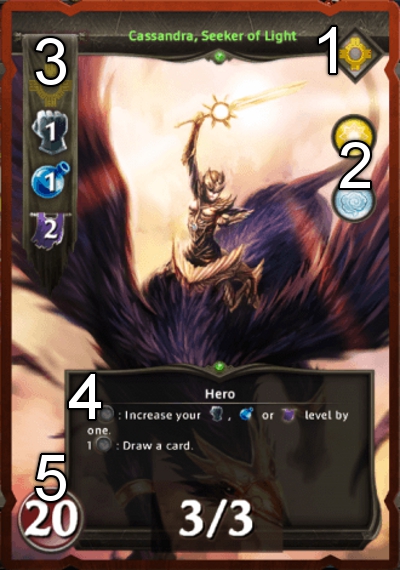
1. Fraction icon in the right-top corner - the symbol that determines which faction's units and Fortune can build the deck under the leadership of this hero. Apart from the specific fraction's there also can be Neutral cards in the deck. The Neutral hero himself does not exist.
2. Round icons on top on the right side of the card - here you can review the schools of magic at the disposal of the hero. There are 1-3 of them.
3. A flag in the upper left corner - it includes information concerning statistics that you receive at the beginning of the match (Might, Magic and Destiny). Often, the starting statistics will allow you to adopt a different tactic, depending on the hero.
4. Box at the bottom of the card - That is where all of the hero's abilities are presented. Apart from the basic skills, you can find here special ones as well, e.g. Sandalphon, Lord of Power has the ability to receive two cost points at the cost of refusing a card. The hero can perform only one of his abilities during the round.
5. Red circle in the bottom left corner specifies the hero's health. Often, having a special power means having less than the standard 20 points of health. If your points drop to zero during a match, you lose. When the opponent's points drop, you win. To all intents and purposes, this is a value that has decisive bearing on the game.
The unit cards are used not only to attack the opponent, and defend yourself. Often, they also perform an important role because, when laid down, they allow you to draw another card from the Helexian Librarian deck. The unit cards often perform the function of cannon fodder but, they can often live longer than it may be apparent at first sight. They can be buffed by increasing their strength (e.g. Blessing) or by healing them (e.g. Healing). By default, Units cannot attack during the turn that they were deployed in (there are exceptions to this rule in the unit's special power concerned with the, so called, Quick Attack).
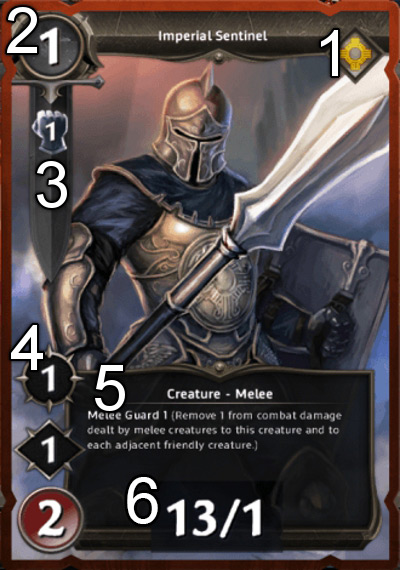
1. The icon of the faction in the upper-right corner -a symbol that allots the card to a specific faction. This unit can belong to a deck constructed on the basis of the hero of the same faction (In this particular case to the Haven only). Neutral cards may belong to any deck because there is nothing like a neutral hero.
2. The circle in the upper-right corner determines the cost, in resources, that you need to bear to deploy this unit in the battlefield.
3. The sword in the upper-right corner is a list of the minimum requirements, concerning the hero's statistics, that need to be met (Might, Magic and destiny) in order to be able to lay down this card on the battlefield. If any of the resources does not appear on the list, this means that it is not required.
4. In the upper-left corner there are three values that determine strength and endurance of the card. The first value refers to the unit's attack. Each time you attack, you can inflict damage, of such value, to the enemy unit/hero.
Counter-attack - if this unit survives the attack of the enemy unit, this is how much damage it will inflict to the enemy.
The amount of health after, which depleted, the card makes it to the graveyard.
5. The box at the bottom of the card tells you which row the card can occupy (in this particular case, it is the front row of the melee attacks)) and lists all of the abilities of a given unit. Most frequently, units have non-unique abilities that repeat throughout e.g. the same faction. The card types are as follows:
Melee attack - Occupies the front row. Can attack only the units deployed directly in front of it.
Shooter- Back row. Just like above, can attack only the units deployed directly in front of it.
Flyer - Can be deployed in any row and attack units hidden in the back row while, at the same time, ignoring the units of the front row.
6. Two figures separated by a "slash" at the bottom of the card provide the information about the amount of owned cards. Does not exist during the round.
Spells are a type of cards where each card is a unique one. They have the ability of changing your situation in the battlefield completely. It works on a principle similar to the Fortume. The difference is that it is, usually, aimed at manipulation with units (the units' attack and defense). Spells only use up the Magic attribute.
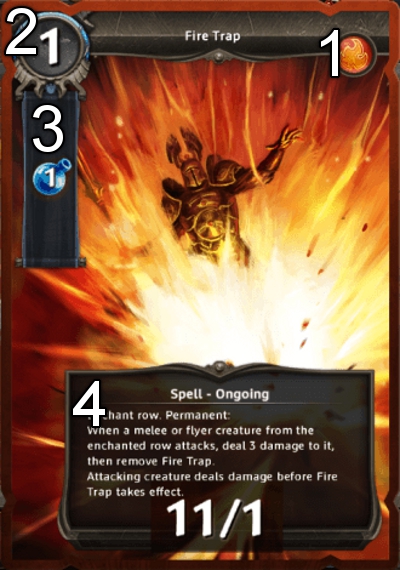
1. School of Magic icon in the upper-right corner- symbol that identifies the card as belonging to a given school of magic. It can be in the deck constructed on the basis of the hero with the same icon.
2. The circle in the upper-left corner specifies the price in resources that needs to be borne while using this Spell.
3. The scroll in the upper- right corner is a list of minimal requirements, concerning the hero, that need to be met. In the case of a spell it is always going to be the attribute of Magic.
4. The box at the bottom of the card specifies what kind of a spell it is and describes its effect. These are the available spell types:
Ongoing- the card remains next to the battlefield, or is laid over a unit and it lasts for a specific period of time
Disposable- This kind of spell takes effect only at the moment of casting, then it makes to the graveyard.
Fortune works in a similar way o Spells but, they do not require the attribute of Magic. They, however require the attribute of Destiny. The good point in Fortune is that it controls resources by increasing, or decreasing their numbers. Often, Fortune works in various ways, depending on the overall situation that you are in.
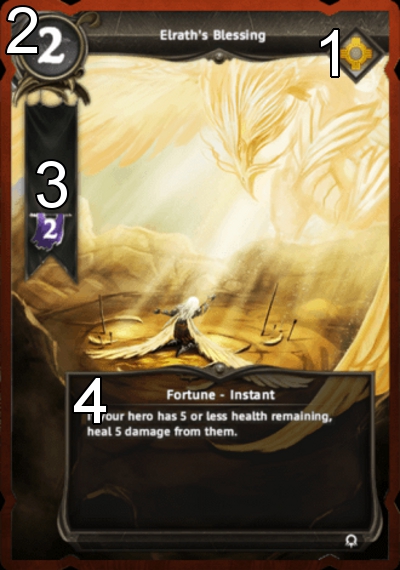
1. The faction icon in the upper-right corner - defines what faction the card belongs to. Fortune can belong to the deck built basing on a hero of the same faction (Haven in this particular case). Neutral cards can belong to any deck because there is no neutral hero.
2. The circle in the upper-left corner specifies the cost, in resources, which needs to be borne to use this card.
3. The sign in the upper-right corner is a list of the minimum requirements for the hero's statistics. In the case of Fortune, it is going to be the attribute of Destiny (it rarely happens that the requirements concern a different resource).
4.The box at the bottom of the card specifies what kind of spell it is and clarifies its effect. These are the available types:
Ongoing - The card remains next to the battlefield or is laid over a unit and lasts for a specific period of time.
Disposable- This type of fortune takes effect only at the moment of casting it is cast, then it makes to the graveyard.
Events are cards which, if used, introduce an increased probability of deteriorating the situation of the user. This is so, because the cards give either bonus or obstruction to both players. Still, it is only the user of the card that bears the cost in resources. These cards are atypical in that you do nod hold them in your hand and they are placed in a specific area where both players can reach and use it. There are two cards displayed at any time, with either of them changed every turn. There also are events that do not need to be played because they activate automatically when a player is in the place where they are played. These cards stand out as ones with glowing edges.
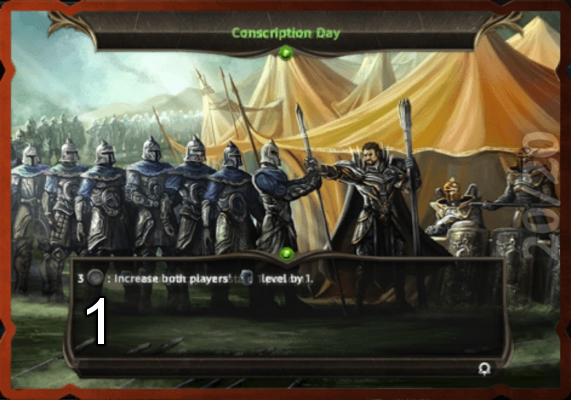
1. On the card, there only is a description of what the event that takes place after the card is played or, while it is active. The cost of playing the card is included in the description but, if it does not appear there, it means that the card activates automatically, without any interaction on the part of either of the players.
After you start the game for the first time (assuming that you have not done so, yet) you will be presented with a choice from among three decks of cards: Inferno, Haven and Necropolis. After you make your choice, you will be playing this deck of cards until you decide to put together a new one or improve the existing one. I would like to mention that the Haven deck is too defensive as for the beginning of the game. It is recommended against to choose this deck if you do not like having it uphill at the beginning of the game.
 An example interface of a player with low experience level.
An example interface of a player with low experience level.
After you make your choice, you will see a very simple interface of the game. On top-left there is account information. Above the standard (1) there is your current ELO (the system of points in ranking games). The standard (1) is your sign and son you will be able to change it. To the right of the standard (2) there is the experience bar which fills up proportionately to the matches played by you. To the right of the bar (2) there is your experience level. Under the experience bar (3) there is a box where all your funds are mentioned (gold, and seals), as well as tournament coupons, which you are going to need if you want to join a tournament. The funds themselves are spent on new sets of cards.
The game is available in Polish. It is a good idea to switch to this language, because, if you start translating cards on your own, you may, eventually, not know what they are all about, or simply misguide yourself. So, to switch into Polish you need to click on the ratchets at the right-bottom of the screen > Options > select the Gameplay tab, if it isn't already open > check Polish in the language list. The only thing left to do here, is restart the game to make the selection take effect. To quit the game, you do the same but, instead of Options, click Quit Game.
In the logging screen you can see that the language has been switched. So, now you only need to log in and carry on with learning about the interface.
If you enter the game for the first time on a given day, you will also see the reward window that grows additional funds for entering the game on a daily basis. Here, you can see your progress in growing these funds, how much it will grow until tomorrow, for entering the game and, if you want to continue growing the reward or to claim it right away. Of course, it pays off to enter on several consecutive days to claim a bigger reward. Still, if you are not sure if you will be able to log in on the next day, and you are bent on claiming the reward, left-click on it to claim the reward. To continue growing, click on the option to the right.
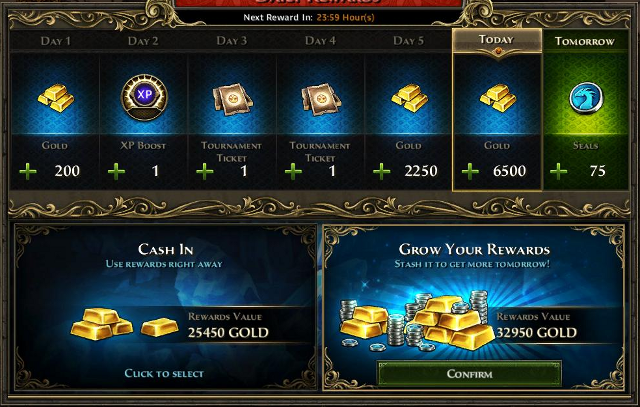
Since you are in the main page now, what you see is a collection of innovations here, introduced by the programmers. The "Play" button (5) and all that you can find after pressing it, has been described in the subchapter devoted to the modes of gameplay. So, to the right of the abovementioned button, there is a simple menu (6).
The first item has been skipped, because clicking on it will take you to the start page which you have already seen. So, the second button refers you to the information about your account. . In the first tab, you can change your standard that you are going to fight under. It only serves as an identification , much like an avatar on the internet forums. The standard can be selected by pressing the arrows under it. Some of the flags are locked, because you will unlock them later on by winning achievements. Next to the flag, it reads "colllectio", which shows you how many cards, of how many possible (does not count doubles), you currently have. Switch to the second tab now, called "achievements". You can see here a list of achievements that you can win, how to win it and, the reward that you will get for unlocking the achievement.
Another (third counting from the left) element in the menu is the shop. By selecting the button to the right, which reads "You need more funds", you can buy more funds like gold or seals. The gold can be gathered by playing a regular game but, the seals can be purchased only with achievements. The shop is divided into three more tabs:
Promoted - you will find here a recommended item from another tab. It is usually a very popular item.
Quick - non-standard offers like tournament coupons or boosts for gold or experience that you win per round.
Packs - The sets of cards are grouped, depending on which series they originate in and their size or the possibility of finding a rare card.
Set- a collection of 10 packages of cards from the same series ( the amount can be checked in the description)
Package - varies, depending on the name (all information in the description)
Premium Pack - a pack that includes a number of premium cards . Each premium card is a reflective card.
Decks - these are the basic decks that you come across while setting up the account. They will help you gather basic cards from a given faction (including the hero's)
Redeem code - this is where you enter the code for a special set.
The collection of your cards includes all of your cards, alongside with the filter that allows you to search for a specific card. Below, you can also edit, or create a new deck. To the right, there is a button which, when clicked, opens packs purchased in the shop. After you open the pack, you will be presented with cards that you got for opening it. Each card can be zoomed in by right-clicking on it. When you introduce changes to a deck or create a new one, the screen is split into two. In the top portion there are cards that can be added to the existing deck. In the bottom portion there are cards that already are in the deck. At this moment, a counter appears at the bottom of each card. This counter is present on all cards from the previous categories. The counter displays how many cards have been added or, how many of them have not been added, depending on what card is currently viewed. The second number tells you how many cards of this type (doubles) you already have.
This section unlocks only after you have gained the 5th experience level of your account. It allows you to get rid of the unwanted cards in exchange for gold. Every card is worth a different amount of gold. The price list is as follows:
Common- 50 gold, Hero- 1000 gold
Uncommon - 300 gold
Rare - 1000 gold (also in the case of a Hero)
Epic - 2000 gold
Premium cards are worth the same amount of gold as their "regular" counterparts. In this section, you can also find an Infernal Card which changes every 8 hours. You can get this card only once. At the beginning of the game, chances of winning it are 0%. To increase your chances, you need to sacrifice other cards. To increase your chances of obtaining such a card, you need to make a more valuable sacrifice, depending on what card it is. The price of the offering sums up. In order to attain 100%, the offering must be twenty times higher than as if you wanted to sacrifice it. E.g. in order to obtain such a card, the offering must be ( 20 * 50 = 1000 ) 1000 gold, at least.
However, in this case, a premium card is worth forty times as much as its basic counterpart. Here is an example for you. If you want to obtain an Uncommon Premium card you need to make a sacrifice for the total value of ( 20 * 300 * 2 = 12000 ) 12000 gold, to have a 100% chance of obtaining it. Of course, you can always risk with a lower value of sacrifices, which results in lower percentage of chances of obtaining it.
The last section, right after the Infernal Pit is Ranking that concerns players from various tournaments or, the overall ranking of players, regardless of their experience. To be promoted in these ranking lists, you need to play tournament games that you access with tournament cards.
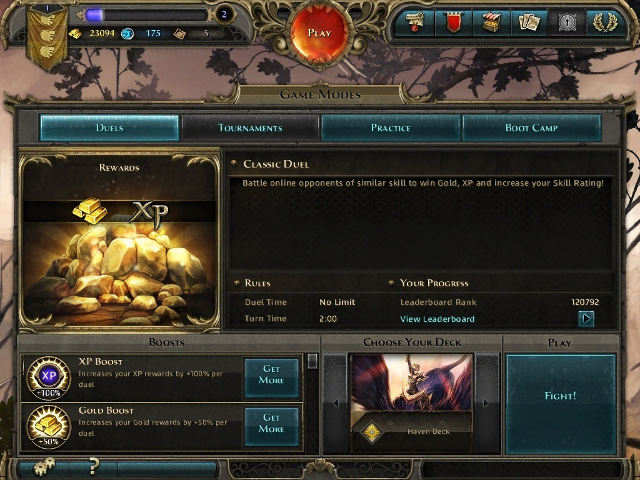
There are 4 game modes. Each one of them sets different requirements for players to meet.
Duels- Duels are the most common mode. For winning here, you receive ELO points, and lose them if you are defeated. You play with a player with ELO similar to yours, chosen at random. Also, for finishing such a duel, you receive experience points as well as gold, regardless of the outcome of the duel.
Tournaments - you can access them after you exceed the threshold of 200 ELO, at least once. For participating in the tournaments, you pay with tournament coupons (only in the case of the case of the Swiss Tournament mode), which usually return to you in the form of rewards. For winning a tournaments, you receive a reward and you are promoted in the overall ranking. There are two types of tournaments where there are different rules. Each day, you can play another type:
Jackpot Tournament- any number of players participate. By fighting, you win points that refer only to this type of tournaments. A player with a higher amount of points can qualify for a more valuable type of reward. The number of players that receive a given amount of gold is unknown so, you cannot be sure to win a bigger amount of gold. In this tournament, battles are fought in a way similar to duels (the same time limit). You do not lose your coupon for participating.
Swiss Tournament - it is a tournament with 8 contestants. Each one of them plays 3 rounds with a random contestant in the same tournament. For the first and the second position, you can receive the Herald of the Void packs, and out of the remaining ones, a random player receives the Emilio pack. There is a catch there, though. During the battle with one of the contestants you only have a total of 7 minutes for all your actions. You play within that time all of your games with one deck of cards of your choice.
Training - these are free games that you do not receive, or lose your ELO points. You can play against the AI, with your friends on the list and people who want to play without the risk of losing their ELO. It is a perfect place to test your new deck and its potential in the battlefield. For playing in this mode, you receive gold and experience points.
Campaign- a series of matches backed up with plot. For winning matches, in the campaign, you can receive interesting rewards. Here, you will be pitted against the AI which, has a different deck of cards and tactic in each round. You can learn in the next chapter how to deal with it with ease.
If the gameplay is different, depending on which deck you have chosen, there will be three points to the game. All of the instructions have been written down basing only on the basic deck (i.e. the one that you receive after you log on into the game for the first time).
In this part of the campaign, you do not really have any freedom of choice and do whatever the tutorial tells you to do. Left-click on the specified unit (it depends on the deck which one it is) and left-click the Ghoul. Then, carry over the second card to block the attack on your hero. After the opponent's turn has ended, finish off the Ghoul in the lower row, and use the other unit to kill the enemy hero. After you have collected your reward, you are ready for the next match
Denstand - Training Grounds
After the opponent's turn ends, and you have gone through all of the tutorial hints, click on your hero and raise the Might statistic to be able to play any card. First, chose the first card to the left, from your hand (the only one highlighted in green) and play it against the enemy Ghoul. Then, end your round. Now, the tutorial has shut down and you are capable of finishing the match freely. Using the card that you played previously, kill the Ghoul and end the round again, ignoring the fact that the Ghoul will attack your hero. If the game asks you if you want to take any action with your hero, answer "No" - you do not need that to win. In the next turn, it is enough to attack the enemy hero with any of your units, deployed in the battlefield, to win the game.
Here, you will see the standard playing area for the first time. To make things easier, it was smaller during the previous matches. After you make your way through all the hints, select the first card to the left and place the unit in the back row, in the second slot from the top. Increase your hero's might and end the round. In the second turn, play the first card to the left to protect the unit that you deployed earlier. After that, use your long-range unit to attack the Skeleton Spearman. After that, end your turn. In the row in which you have fought most recently, kill the enemy units. End the round and, respond "No" in the box that has just appeared. Your opponent stopped playing his cards, which means that he is vulnerable now. Therefore, attack the enemy hero with both units. End your round and finish the enemy off, in the next one, with one of your cards.
To start with, rise your hero's Magic level, so that you can play a spell now. Play a spell on the row where the enemy played two of his cards. Then, end the turn. Select the specified Fortune card, play it and confirm your choice. Raise your hero's might and play the two available cards in two different rows (one at the very bottom and the second in the second slot at the bottom). In the next turn, use these units to smash the enemy units and deploy further units in the same rows (so that they are next to each other), and finish the next round by killing the enemy hero.
#Harbor#
Start by increasing your hero's statistics of magic, use the Cleansing Light card and confirm your choice. Use the already deployed Sea Elf Archer to kill the remaining enemy unit and end this turn. Note that the enemy hero is still a hero placed there by the tutorial because it has only 4 health points. Now, go into the offensive mode. Deploy one Imperial Archer in every possible slot and kill the unit standing in front of the Sea Elf Archer. End this turn and ignore raising your hero's statistics or, raise just anything. One of your units died but do not worry and finish off the enemy hero.
It is the first match in which the computer stands any chances. Also, from now on, you receive cards in a pre-defined order, unlike in a regular match. The only thing that makes it all easier, is the decreased health of the enemy hero, to a half. The game is played with adherence to individual rounds.
1. Start by deploying the Imperial Sentinel in the second row from top, and by raising your hero's attribute of might.
2. raise the attribute of might again. Deploy the Wild Griffin in the front row, in front of the enemy. .
3. Behind the Griffin, deploy a Sea Elf Archer. From now on, increase the attribute of magic every round, to reach 4. In the row at the very top, deploy the Imperial Crossbowman. Attack the enemy hero with the Wild Griffin at the end of this round.
4. deploy an Imperial Crossbowman again, in the same position. Kill two enemy units in the row occupied by your Griffin, it is up to you in which order). Use the Fountain of Youth Fortune card.
5. Now, your magic attribute should equal 4. Replenish your Wild Griffin's health, using the healing spell. Use the Cyclone spell over the enemy's front row. Use the Griffin to finish off the unit in front of it. Use the Elf to attack the second unit in this row. Attack the enemy hero with the Imperial Bowman.
6. raise the destiny attribute. Deploy the Sun Rider in the bottom row and play the Word of Light. Use the Crossbowman to attack the enemy again, and the Griffin to finish off the unit in front of it.
7. Play the Bless card on your Crossbowman and use it to attack the enemy hero. Play the Campfire card, use the hero's ability to draw cards and use the Celebration event card. Once you have the Sunburst card, use it against the enemy standing unit with low health. Use the Rider to attack the enemy unit behind it. .
8. The only thing left to do in this round is use the Imperial Crossbowman to defeat the enemy hero.
From now on, all of the matches, in the campaign mode, are based on the random hand, both yours and the computer's. Therefore, the tactics described from here one are of the theoretical nature only, whose performance it is good to try out.
Haven: Take the first shuffle cards only if you have the Imperial Guard or Imperial Crossbowman, whose cost is one resource point, or if there is the Sun Rider there. It is very good if you have cards that meet both requirements. During the match, the hero's attributes should be raised to 3-4-3 at least, in the order from the left. After that, you may draw further cards. Try not to use events. Pay attention to the fact that the enemy only has 10 health points. The devoted Sister cards should be used as cannon fodder to cover your hero. <br>If you have not drawn the Sun Rider, and you have drawn it during the match, base your success on that card and deploy it in an unprotected, or weakly protected row. . Before you do deploy that card, however, try to play the event card called the go Week of the Weaponsmiths. Only on the condition that you have 6 resources (otherwise you will not have enough for this action). Right after your magic attribute rises to 4, use the Cyclone, Word of Light and Sunburst to kill the enemy units. Focus on killing all the units that are in the same row as your Rider. If necessary, use Healing on him or, if you can, increase its might using the Bless spell. Thanks to focusing on it, your rider will have no problems winning the match.
Inferno: In this case, if you want to deal with the enemy quickly, it is a good idea to start with body-less units. It is good to have, at the beginning, two Succubus and, at least, one Firebolt. Out of your statistics, raise might mainly, and try to get the abovementioned Succubus deployed. If you have to, try to cover them with the other units and, with the Succubus themselves, try to escape along rows to get out of the enemy's range.
Necropolis: If you want to deal with the enemy quickly, you could start with body-less units, i.e.: Lingering Ghost, Lesser Shadow Elemental. Thanks to these units, you incredibly outpower the enemy. While poisoning the enemy with the ability of infection, the typical remnants will die out on their own. To win, you simply need to play with your numbers that are greater than the enemy's
At the beginning of this match, the enemy is at an advantage. Not only does he have the same amount of health points as you, but also receives two units deployed in the battlefield.
Haven: In this round, it is not going to be that easy for you. While starting, you need to hold low-cost cards in your hand, the best if they are no more expensive than 2 resource units. During the initial turns, try to raise the magic attribute, so that it reaches 4 as quickly as possible. Only after that, raise your might attribute, because the enemy already has a lot of cheap, weak cards. Thanks to spells, you will be able to keep the battlefield under control enough to prevent the enemy fill all of his unit slots. An important aspect is to use cards like Lightning Bolt not against the units that can take the most damage from it, but against the ones that stand in your way to the enemy hero (use a spell only as an one-time means of clearing the path for yourself, and only if you can still attack in the same turn). It may turn out that the Sun Rider is very useful but, remember that the enemy is trying to play his numbers so, betting on one card only may turn out to be fatal. The Word of Light spell will often be capable of purging the battlefield of the enemy units entirely. After some time off, at least, repelling the enemy, you will notice that he has around 4 of them in his hand. He will start to deploy one, or two, at a time. Try to block the lines effectively and the threatening units (e.g. in an exposed row), eliminate with spells. Also, do not hesitate to use your hero's ability and draw additional cards. At the same time, avoid using the Celebration event card because this will make the match easier for your opponent and not necessarily for you.
Inferno: A good hand to start with is a cheap one. A hand where you will have the units of the cost not exceeding 2 resource units. The Opponent will be laying down a lot of cards. At the beginning, the Maniac, Cerberus and Hellhound make good cards because, thanks to widespread attacks, you can wipe out the units on a mass scale. The Fiend can help finish off the enemy units that are low on health. It is important not to expose more than one row because, you can take a lot of damage towards your hero.
Necropolis: Theoretically, you should experience no problems here playing the Necropolis. It suffices here to attack with masses and keep raising the might attribute.
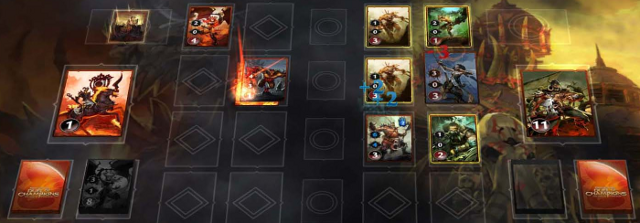
This time around, the opponent does not rely on attacking with masses, but rather he goes for the more expensive and stronger ones. Use this fact to your advantage and try to wreak havoc from the very beginning, by starting with a cheap hand and raising the might and the magic attributes, until they both reach 4. Focus on deploying mass units to secure all rows and forming the, so called, fortifications.
Haven: If only you have the opportunity to, heal the unit that was more expensive than 3 resource units and, if you can, deploy the Seraph or the Sun Rider in the slots where they will have to fight because, these are that will easily win this match.
Inferno: Do not leave the passage to your hero open. Try to use the Fire Bolt and fire Ball spells to kill as many enemy units as possible.
Necropolis: If any unit in particular gives you hard time, it is a good idea to use the Death Seal and Agony spells.
To an extent, you will be fighting a clone of yours here. While fighting, do not try to attack or defend too much. Just do whatever you can to prevent the opponent from launching a good attack. A good example of counter-acting is: if the opponent casts the Blessing on a unit, use Lightning Bolts straight away to destroy that unit. Defend every possible row and lay down cards that are comparable to what your opponent uses. Take advantage of the fact that your enemy is holding the Month of the Emerald Song and the Week of Weaponsmiths event cards and, by laying down same, or comparable cards, you will be able to improve them, by adding 2 additional health points to make a good start, or by increasing the attack by one.
If you know that, by attacking with two units you will be able to destroy an enemy unit, it is better to start this attack with the unit that has the ability called Retaliation Immunity. Later on the opponent will run out of card to play more than one or two at the same time. Thanks to it you will be able to deploy assault units in a big number of slots and, every newly deployed enemy unit will disappear from the battlefield straight away. This battle may take long but, only with your discernible advantage.
To start this series of matches against the AI, you need the 3rd experience level, at least. You start the game with one unit already deployed in the battlefield.
Your opponent will put up resistance in the form of a large number of units that can drain health and regenerate theirs. Still, he will soon run out of cards so, it suffices to block all of the access routes to your hero with as many units as you can, and to use all the possible spells. After you raise attributes to 4-4-3 (start by raising the might attribute to 4), draw cards from the deck. It is best if the start hand is cheap and mostly with units. The number of your units is a key to success.
It can be quite troublesome to fight this opponent, as he has a whole lot of Lost Souls, who take half the damage from non-magical units. I.e. from the majority of your units. .
Haven: the only way to win is to defend the hero with weak units and to focus on magical attacks at the beginning. A good hand for a start has four offensive spells and cheap units. Start by raising might attribute to 2, and then increase magic to 4 and then, raise might to 4. If you can, lay down the magical unit cards, i.e. Radiant Glory and Lesser Air Elementals, and keep using Blessing on such cards only. In this round, you need to focus on attacking mainly with two magical units that you have, i.e. Radiant Glory and Lesser Air Elementals. It is an important thing to deploy them in the front row and to heal them because you have only few of them in your decl. Use the other cards in the form of cannon fodder, to protect your hero. If you manage to play properly at least one card with magic attack, you stand considerable chances to win.
Inferno: Try to defend at the very beginning of the round and use the House of Madness, as soon as the opponent starts running out of units in the battlefield. This will make him throw one card after another, thanks to which you will win by having more cards than him.
Necropolis: Your cards are similar to those of your opponent's. Many of them are magic cards, which will help you deal with the enemy.
Haven: Start with a cheap hand. You need to deploy as many units as you can, in a short period of time, to block the enemy's attacks. The enemy has a great power of poisoning at his disposal, but you can easily counter-act against this one, by deploying devoted Sisters next to the poisoned units. The attributes need to be raised as follows: 3-4-3, starting with might and ending with destiny. The enemy will be fast to deploy new units but, you can easily maintain control over the battlefield by using offensive spells. Attack as soon as you can with whatever you can. Heal your units with the blessing, but the poisoned units. If your units will make through the initial phases of the match, unlike the opponent's, and both of you will be left with few cards on the hand, this will mean your victory.
Inferno: It is a good idea to use the House of Madness to prevent the torrent of the enemy's cards. In general, there is no huge bonus in the game for you to remove poison. Counter-attack the stronger creatures by using the Fire Shield on the poisoned unit.
Necropolis: Another battle with a clone of yours. You can try and mirror the opponents moves to get him cornered.
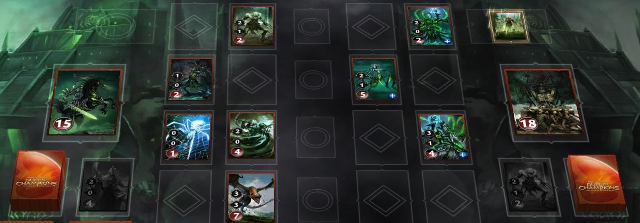
You start the game at a disadvantage, when it comes to deployment. This will be easy to remedy, though. Try to start the match with a hand, where there are, at least, two units for 1 resource units. This will help you survive the initial phase.
At first, invest in the magic attribute, and try to clear the battlefield, even if it comes at the cost of your own units. At the beginning, try to use cards that will block the opponent's attacks. After you have protected your hero for, around, 5 turns, you will finally be able to fight and deal some damage to the opponent. Use the Campfire card to gain more cards.
Your opponent will rely on manipulation and, to a large extent, he will be also eliminating his own units. A good way to survive is healing one of the stronger cards. After you dominate one line, you stand more chance to win, even if you are made to defend yourself at the other lines and to sacrifice your units.
One of the more popular tactics is the one known as the OTK (One Turn Kill), which means killing in one turn. As the name itself suggests, this tactics is based on waiting the right moment to kill the enemy right after he notices that you have deployed your first, and last unit. You can tamper with this tactics and modify it to suit your needs (if you do not have the suitable ones of your own) but, it goes without saying that this will decrease the effectiveness of performance.
Ok so, if you already know the theory, it is time to get down the business, i.e. how to pull off this, so called, OTK. For this, you are going to need a special Stronghold deck. Start by selecting your hero. The hero should have, at least, two available schools of magic (do not ever select Kassar, Blackskull, your best choice is Shaar, Invoker of the Skies). Now you need to select appropriate cards for your hero. Select the event cards as follows: Celebration and Day of Fortune, four of each. In terms of units, it is very atypical because you pick one to four unit cards. The most important of these is the Enraged Cyclops, take two of these. If possible, you can also add Pao Deathseeker in the amount not larger than two. It is time for spells now. The spells will be a decisive force in the deck because, they will allow you to wait up to the, say, 10th turn, when you will be able to kill the opponent's hero. It is a good idea to add cards that have AOE (Area of Effect - territorial) damage. Such cards are mainly: Heat Wave, Forbidden Flame, Fire Storm, Cyclone and the Insect Swarm. To protect your hero, you can also do with the Stone Shield. The last, but not the least are the Fortune cards. You are going to need: Gold Pile, Campfire, Call to Duty (used if you want to start the combination but you do not have the Cyclops on your hand), Broken Bridge, Crystal of Power, Wasteland, Blood Shaman Hut and Grand Finale Kat.
It is time to start the game. While playing, eliminate all the enemy units, if possible, and try to draw as many cards as possible. Once you have enough resources, or can raise their amount, kill the enemy. Play the Grand card and deploy the Cyclops and the Seeker (one of each). Rise the Cyclops's strength with the Huts, as much as you can, and attack with both units. If you have performed it correctly, your enemy should be dead already.
And what if you will have to defend against such tactic? With your own deck of cards and gaming style, you can easily protect yourself from the OTK. It is enough to have the cards that remove the effect of the ongoing spells (e.g. the Crystal of Revelation) and, while the enemy is defending himself with spells that prevent you from attacking him, you will be able to find a way around and kill him.
This atypical tactic allows you to extend full control over the entire battlefield. It does not have a specific set of orders that concern the movements. It is more of a set that combines cards in such a way, as to let them have control over the battlefield. The tactic is based on the Sanctuary and the hero called Kaiko, Invoker of the Depths. After you select this hero, you need to make a selection of units. It is not clearly specified how many units you need to chose, and of what kind. The important cards are, however Snow Maidens and Coral Priestesses, it is thanks to them that you will be able to attack the enemy and manipulate him. The Fortune card that may come in handy during mass attacks is the Avalanche. When it comes to spells, the most important thing that you need to take, is cards that will allow you to re-position the enemy units, or return them the enemy's hand.
And now, the gameplay itself. The abovementioned units, and other cards, will allow you to manipulate the enemy units, thanks to which, you need to try and re-position the enemy units to make a gap through which to attack. The There is a downside of this tactic, though. If you re-position an unit in a wrong way, you may expose your hero which lets the enemy strike, which can be avoided through spells. A good example to perform a basic attack is to deploy a Priestess in front of the only enemy unit and, to use the Maiden in the next turn to move that unit to the Maiden's front. Then, attack with the Priestess. In the next turn, after the Priestess's attack, move the enemy unit with a spell to her front, and attack with the Maiden. This way, it is possible to keep defending your hero and attack the enemy's hero.
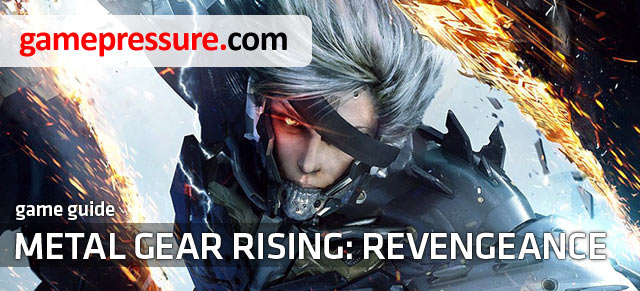
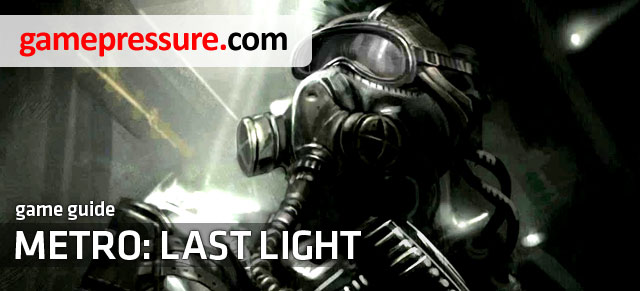
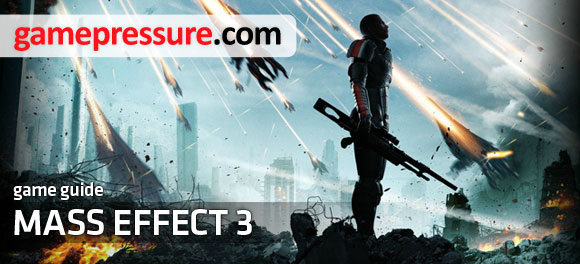
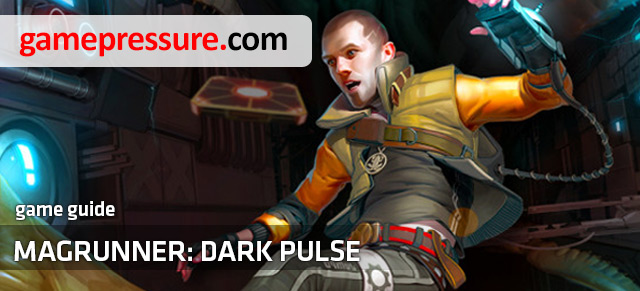
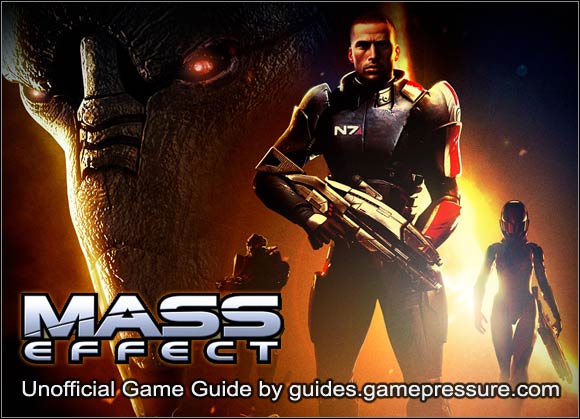 Mass Effect Game Guide & Walkthrough
Mass Effect Game Guide & Walkthrough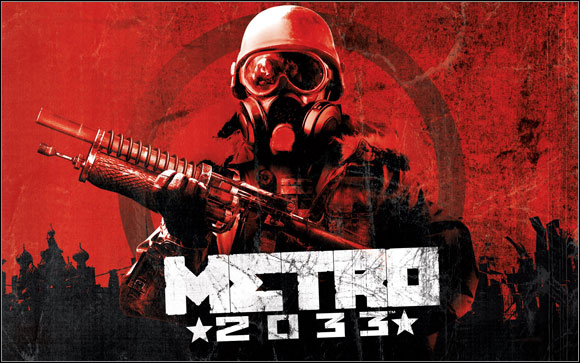 Metro 2033 Game Guide & Walkthrough
Metro 2033 Game Guide & Walkthrough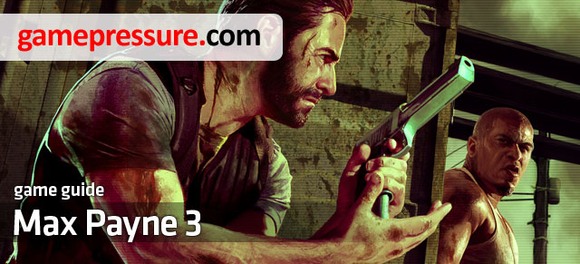 Max Payne 3 Game Guide & Walkthrough
Max Payne 3 Game Guide & Walkthrough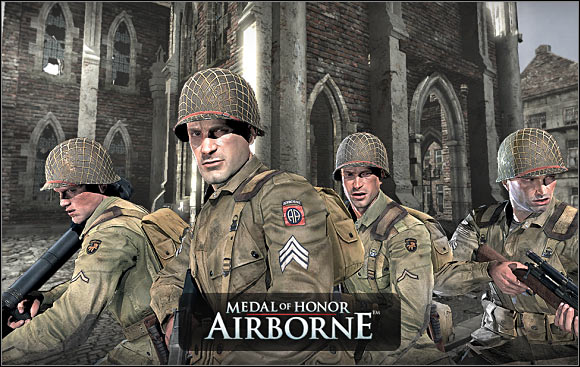 Medal of Honor: Airborne Game Guide & Walkthrough
Medal of Honor: Airborne Game Guide & Walkthrough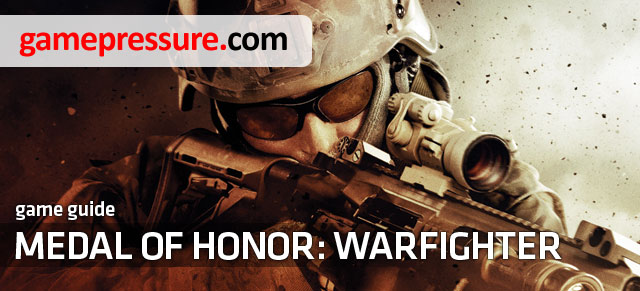 Medal of Honor: Warfighter Game Guide & Walkthrough
Medal of Honor: Warfighter Game Guide & Walkthrough